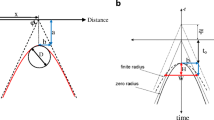Abstract
This study attempts to quantify the ground penetrating radar rough ground surface clutter by numerical modeling of wave scattering, and establish a strategy to suppress the clutter for given test signals. The goal is to improve the GPR detection statistics for small, buried, low-contrast nonmetallic antipersonnel mines. Using a model of an experimentally measured impulse GPR signal, we simulate the ground surface and buried low-contrast mine target scattered responses. We employ a 2D finite difference time domain (FDTD) method to analyze the pulse shape, delay, and amplitude characteristics of the scattered waves—with and without buried nonmetallic mine targets—as a function of roughness parameters. Five hundred Monte Carlo simulations of various test cases of specified ground root mean square height and correlation length were run to generate statistics for the clutter and target signal variations. In addition, the effectiveness of identifying and removing the ground surface clutter signal for detecting subsurface targets is presented. Results indicate that even with moderate roughness, statistics can be generated to enhance the detection of small, shallow, low-contrast targets.
Similar content being viewed by others
References
Peters, L. and Young, J., 1986, Applications of subsurface transient radars, I, in Miller, E. (ed.), Time Domain Measurements in Electromagnetics: Van Nostrand Reinhold, New York.
Weedon, W. and Rappaport, C., 1997, A general method for FDTD modeling of wave propagation in arbitrary frequency-dispersive media: IEEE Trans. Ant. Prop., v. 45, p. 401–410.
Rappaport, C., Wu, S., and Winton, S., 1999, FDTD wave propagation modeling in dispersive soil using a single pole conductivity model: IEEE Trans. Magnetics, v. 35, p. 1542–1545.
Rappaport, C. and Winton, S., 2000, Using the PML ABC for air/soil wave interaction modeling in the time and frequency domains: International Journal of Subsurface Sensing Technologies and Applications, v. 1, p. 289–304.
von Hippel, A.R., 1953, Dielectric Materials and Applications: Technology Press of M.I.T. and John Wiley, New York.
Sahin, A., Rappaport, C., and Dean, A., 1998, Design considerations for short time pulse TEMR antennas using finite difference time domain algorithm: SPIE Aerosense Conf., Orlando, FL, p. 784–793.
Beckmann, P. and Spizzichino, A., 1963, The Scattering of Electromagnetic Waves from Rough Surfaces: Macmillan, New York.
Thorsos, E., 1988, The validity of the Kirchhoff approximation for rough surface scattering using a Gaussian roughness spectrum: J. Acoust. Soc. Am., v. 83, no. 1, p. 78–92.
Mood, A., Graybill, F., and Boes, D., 1974, Introduction to the Theory of Statistics: McGraw-Hill, New York.
Hipp, J., 1974, Soil electromagnetic parameters as functions of frequency, soil density, and soil moisture: Proc. of IEEE, v. 62, no. 1, p. 98–103.
Bass, F. and Fuks, I., 1979, Wave Scattering from Statistically Rough Surfaces: Pergamon, New York.
El-Shenawee, M. and Rappaport, C., 2000, Quantifying the effects of different rough surface statistics for mine detection using the FDTD technique: Proc. SPIE.
Warrick, A., Azevedo, S., and Mast, J., 1998, Prediction of buried mine-like target radar signatures using wideband electromagnetic modeling: Proc. of SPIE, v. 3392, p. 776–783.
Author information
Authors and Affiliations
Corresponding author
Rights and permissions
About this article
Cite this article
Rappaport, C., El-Shenawee, M. & Zhan, H. Suppressing GPR Clutter from Randomly Rough Ground Surfaces to Enhance Nonmetallic Mine Detection. Subsurface Sensing Technologies and Applications 4, 311–326 (2003). https://doi.org/10.1023/A:1026352615393
Issue Date:
DOI: https://doi.org/10.1023/A:1026352615393




